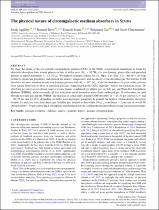| dc.description.abstract | We study the nature of the low-redshift circumgalactic medium (CGM) in the SIMBA cosmological simulations as traced by
ultraviolet absorption lines around galaxies in bins of stellar mass (M > 1010M) for star-forming, green valley and quenched
galaxies at impact parameters r⊥ ≤ 1.25r200. We generate synthetic spectra for H I , Mg II , C II , Si III , C IV , and O VI , fit Voigt
profiles to obtain line properties, and estimate the density, temperature, and metallicity of the absorbing gas. We find that CGM
absorbers are most abundant around star-forming galaxies with M < 1011 M, while the abundance of green valley galaxies
show similar behaviour to those of quenched galaxies, suggesting that the CGM ‘quenches’ before star formation ceases. H I
absorbing gas exists across a broad range of cosmic phases [condensed gas, diffuse gas, hot halo gas, and Warm-Hot Intergalactic
Medium (WHIM)], while essentially all low ionization metal absorption arises from condensed gas. O VI absorbers are split
between hot halo gas and the WHIM. The fraction of collisionally ionized CGM absorbers is ∼ 25–55 per cent for C IV and
∼ 80–95 per cent for O VI , depending on stellar mass and impact parameter. In general, the highest column density absorption
features for each ion arise from dense gas. Satellite gas, defined as that within 10r1/2,, contributes ∼ 3 per cent of overall H I
absorption but∼ 30 per cent of Mg II absorption, with the fraction fromsatellites decreasing with increasing ion excitation energy. | en_US |

